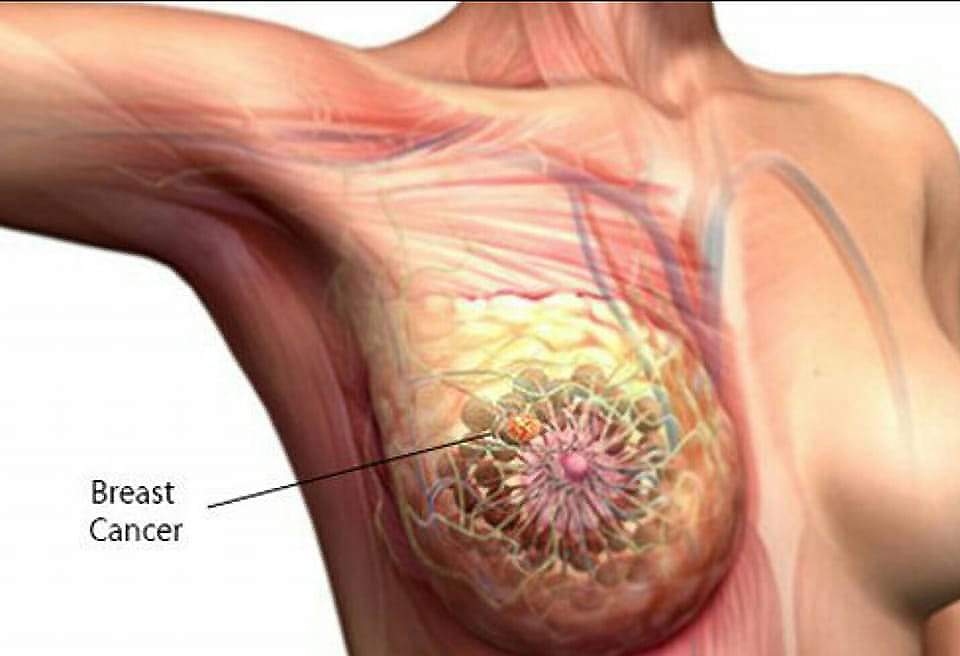
- Definition: Breast cancer is a malignant tumor that forms in the cells of the breast, most commonly in ducts or lobules.
- Common Types: Includes Invasive Ductal Carcinoma (IDC) and Invasive Lobular Carcinoma (ILC).
- Symptoms: Lump in the breast, nipple discharge, skin dimpling, or breast shape changes.
- Risk Factors: Age, family history, genetics (BRCA1/2), obesity, alcohol, and hormone therapy.
- Diagnosis: Through mammogram, ultrasound, MRI, and biopsy.
- Treatment: Includes surgery, radiation, chemotherapy, hormone therapy, and targeted therapy.
Breast Cancer: In-Depth Overview
Breast cancer is a disease in which malignant (cancer) cells form in the tissues of the breast. It is the most common cancer among women worldwide, but can also affect men in rare cases. With early detection and effective treatment, many people survive breast cancer and live full lives.
🧬 Types of Breast Cancer
Breast cancer is classified based on where it begins and whether it has spread.
1. Based on Location:
- Ductal Carcinoma in Situ (DCIS): Non-invasive, confined to the milk ducts.
- Invasive Ductal Carcinoma (IDC): Most common type; starts in ducts and spreads to surrounding tissue.
- Invasive Lobular Carcinoma (ILC): Starts in lobules (milk-producing glands).
2. Special Types:
- Triple-Negative Breast Cancer: Lacks estrogen, progesterone, and HER2 receptors—more aggressive.
- HER2-Positive Breast Cancer: Overexpresses HER2 protein; responds well to targeted therapy.
- Inflammatory Breast Cancer: Rare and aggressive; causes swelling and redness.
- Paget’s Disease of the Nipple: Starts in nipple ducts and affects the skin of the nipple/areola.
⚠️ Signs and Symptoms
Breast cancer symptoms can vary, and some people may have no signs at all, especially in early stages.
Common symptoms include:
- Lump or thickening in the breast or underarm
- Change in breast size or shape
- Dimpling or puckering of skin
- Nipple discharge (especially bloody)
- Nipple inversion or change in appearance
- Redness, scaliness, or swelling
- Pain in the breast or nipple area (though most lumps are painless)
🧪 Causes and Risk Factors
Risk Factors You Can’t Change:
- Gender (being female)
- Age (risk increases with age)
- Family history of breast or ovarian cancer
- Genetic mutations (e.g., BRCA1 and BRCA2)
- Personal history of breast cancer or certain non-cancerous breast conditions
Lifestyle-Related Risk Factors:
- Hormone replacement therapy (HRT)
- Early menstruation (before age 12) or late menopause (after 55)
- Never being pregnant or having a child after 30
- Obesity
- Excessive alcohol use
- Sedentary lifestyle
🔬 Diagnosis
- Clinical Breast Exam – Doctor checks for lumps or changes.
- Mammogram – X-ray of the breast; used for screening and diagnosis.
- Breast Ultrasound – Helps distinguish between solid and fluid-filled lumps.
- MRI – For high-risk cases or detailed imaging.
- Biopsy – A sample of tissue is taken to confirm cancer type and grade.
📊 Stages of Breast Cancer
Staging helps guide treatment and predict outcomes.
- Stage 0: Non-invasive (DCIS).
- Stage I: Small, localized tumor.
- Stage II: Larger tumor or spread to nearby lymph nodes.
- Stage III: More lymph nodes involved or larger area.
- Stage IV: Metastatic — cancer has spread to other parts of the body (e.g., bones, liver, lungs).
💉 Treatment Options
Treatment is tailored based on type, stage, and receptor status (ER, PR, HER2).
1. Surgery
- Lumpectomy: Removal of tumor and small margin.
- Mastectomy: Removal of entire breast.
- May include lymph node removal.
2. Radiation Therapy
- Used after surgery to kill remaining cancer cells.
- Often recommended after lumpectomy.
3. Chemotherapy
- Used before (neoadjuvant) or after (adjuvant) surgery.
- Kills fast-growing cancer cells throughout the body.
4. Hormone Therapy
- For ER/PR-positive cancers.
- Includes drugs like tamoxifen or aromatase inhibitors.
5. Targeted Therapy
- For HER2-positive cancers (e.g., trastuzumab/Herceptin).
- Specifically attacks cancer cells without harming normal cells.
6. Immunotherapy
- For certain aggressive cancers like triple-negative breast cancer.
🔄 Prognosis and Survival
- Early detection significantly improves survival.
- Stage I breast cancer has a 5-year survival rate of ~99%.
- Stage IV survival drops to about 30%, but treatment can extend life and improve quality.
🛡️ Prevention and Screening
Prevention Tips:
- Maintain a healthy weight
- Exercise regularly
- Limit alcohol
- Avoid smoking
- Consider genetic counseling if at high risk
- Breastfeed if possible
Screening Recommendations:
- Monthly self-exams
- Clinical breast exams every 1–3 years (ages 25–39)
- Annual mammograms starting at age 40–50 (based on risk factors)
✅ Conclusion
Breast cancer is highly treatable, especially when detected early. Awareness of symptoms, regular screenings, and understanding your personal risk are key to reducing the impact of this disease. Advances in treatment continue to improve outcomes and quality of life.

